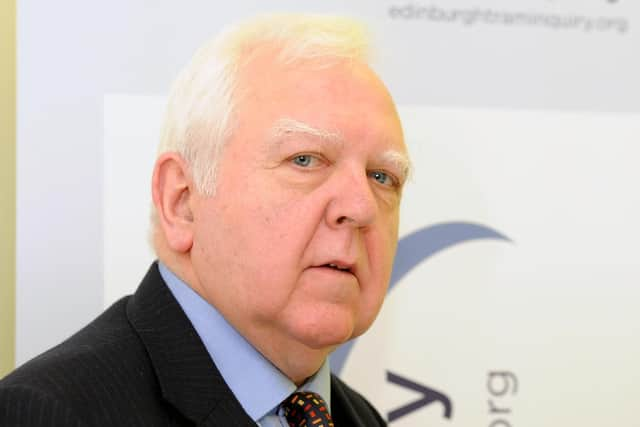Nine-year official probe into the capital’s disastrous tram line construction project to report shortly
Almost exactly nine years ago, and days after Edinburgh’s hugely-delayed and over-budget tram line finally opened to passengers, the then First Minister Alex Salmond announced a public inquiry into the fiasco.
That investigation, which has lasted far longer and cost far more than expected, appears to be about to conclude with the impending publication of chairman Lord Hardie’s long-awaited report.
Ironically, the inquiry, which was established to learn lessons from the tram line project that went so badly wrong will now produce its findings only after an extension of the route to Newhaven has been completed with no major hitches, with passenger services due to start on Wednesday June 7.
Construction of the £207 million, three-mile spur via Leith Walk, whose route is shown in this driver’s eye video by city council transport convener Scott Arthur, started in November 2019.
The original 8.5-mile line between Edinburgh Airport and York Place at the east end of the city centre cost £776m – more than £200 million over budget, and took seven years to complete. It opened three years late on May 31 2014, and was far shorter than the originally-planned two-line scheme that would have included a loop via Roseburn, Granton and Newhaven.
The work also caused massive disruption to the city centre, especially around Princes Street, as well as during preliminary work on Leith Walk before that section of the line was shelved.
A significant factor in the fiasco was the major fall out between Edinburgh City Council’s tram firm Tie (the former Transport Initiatives Edinburgh) and a consortium of construction companies which built the line, including over incomplete designs.


That followed ill-tempered outbursts, such as Edinburgh Trams chairman David Mackay describing principal contractor Bilfinger Berger as a “delinquent contractor who scented a victim”. He quit his post in 2010, calling the project “hell on wheels”.
The tram scheme also suffered major problems during preliminary work which started in 2007 to move underground pipes and cables from the route, with far more having to be replaced than planned, and unexpected obstacles being encountered.
Construction of the line started in 2008 but hit major problems the following year when a row blew up between Tie and the contractors over the cost of work in Princes Street.


The project was also marred by political turmoil after being launched by the Labour-run city council in 2003 then continued by the subsequent Liberal Democrat administration in the face of opposition from the SNP, which attempted to get the tram line scrapped when it came to power at Holyrood in 2007.
Announcing the inquiry on June 5 2014, five days after the line opened, the Scottish Government said it would investigate “why the project incurred significant overruns in terms of cost and timing requiring, in particular, a considerable reduction from its original scope”. This would involve examining the scheme’s “governance, project management and delivery structures, and oversight of the relevant contracts”.
A week later, Mr Salmond said he looked forward to a “swift and thorough inquiry” as he unveiled former Lord Advocate Lord Hardie as its chair.
However, the inquiry’s first public hearing did not take place for more than a year until October 2015 while its team sifted through more than 6 million emails and other documents from a potential pool of 500 million.
An inquiry spokesman insisted that the setting of a date for that preliminary hearing “underlined the continued good progress” of the inquiry, while Lord Hardie hit back at critics complaining about the pace and cost of the inquiry, saying his team was “working flat out”.
He said: “If the public want an inquiry into what went wrong, and if they want the answers to why there was such a huge overspend, why it took years longer than it should, and why the line was curtailed, then hopefully they will appreciate that it is quite a large task to give these answers, and it involves examining a huge number of documents.”
Lord Hardie said there would be more than 65 “areas of interest” in the inquiry, grouped in 12 areas. He pledged that it would “provide the public with the answers they want and deserve to have”.
During the eight months of main public hearings, which did not get underway until almost two years later, in September 2017, nearly 100 witnesses were called.
However, Lord Hardie has stressed that most of his deliberations would be based on written evidence, to be elaborated on orally where required.
He also underlined his keenness to hear how the tram work had affected people’s lives – “the consequences on householders, businesses and developers, including in neighbouring streets where traffic was diverted”.
In the five years since the hearings ended, concerns have increased about the time the inquiry has taken and its mounting cost, which is expected to top £13m.
Warning letters were sent to those to be criticised in the inquiry report to give them a chance to respond, as Scotland on Sunday revealed in November. Recipients, who are believed to have included several former Edinburgh city councillors and senior Tie officials, were given until December 2 to reply.
An inquiry spokesperson said the report “will be finalised after all responses have been received and considered”.
